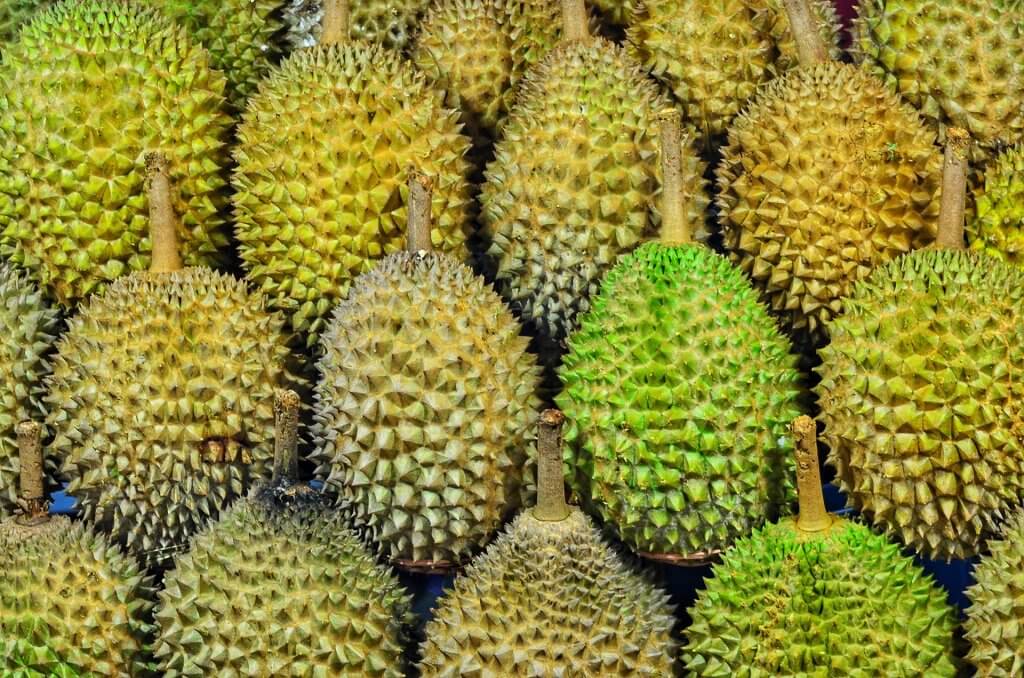
I know something about you. You’re one of two kinds of people: you either love durian, or you haven’t had properly ripe durian. Or you’re indifferent. Or you hate it – but let’s ignore the latter two categories for dramatic effect)
In this article, I’m going to show you the real way to pick durians easily. No nasty overripe durians, no tasteless cinderblocks, and no getting cut while fumbling around with the sharp spikes of one of the tastiest fruits on the planet.
Why You May Not Have Ever Had a Properly Picked Durian
I love durian. Through and through. I even keep it as air freshener. I also love that people hate it, because it helps keep the price down; but, unfortunately for them, I suspect that a lot of the dislike of durian has to do with people not being able to pick durian at its correct ripeness (hint: when it’s ripe, its already too ripe), and thus getting a smelly, soggy, nasty durian experience that even I won’t indulge in, despite durian being my favorite fruit by far.
Now, if you’re in the latter category, you may be saying:
“Shut up, I’ve been to Thailand/Malaysia/Indonesia/the Philippines/China/Vietnam/Singapore/Borneo/Brunei/etc., I’ve had durian. The local guy at the fruit stand picked it for me.”
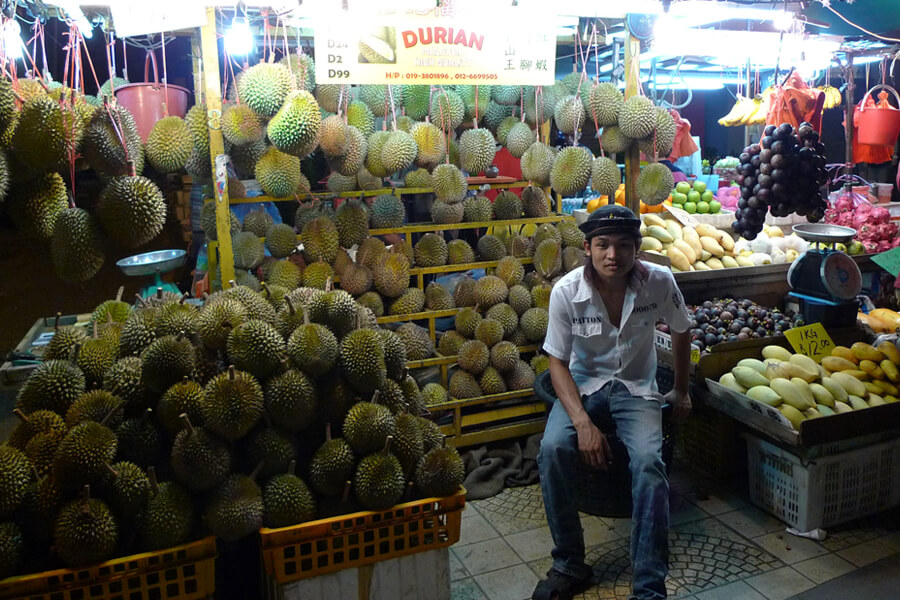
Whether it was the street vendor giving you a sub-par durian under the logic that you’re a tourist, and you’re neither discerning enough to know the difference nor going to be around enough to give him repeat business, or if it was your own attempt to pick a durian from said vendor (or a supermarket), there really is only one way to pick a proper durian, and if you haven’t been using it, you’ve left the process up to chance, and may not have ever had a durian at its most delicious.
One way?
Yes. One way. Only one way.
And it doesn’t involve that “tappy stick”, nor most of the “common wisdom” that’s spouted.
Like What You See?
Before we get to it, I’m going to dispel some of the rumors out there about picking durians.
How NOT to Pick Durian
There is a lot of “common wisdom” floating around on how to pick an ideal durian. (Notice I didn’t call it “ripe”. Stay away from the advice of anybody who tells you how to pick “ripe” durian – because ripe durian is rancid durian.)
You may even be doing some of these things, and chances are, that if you’re reading this, you know they don’t reliably work, because your durian picks aren’t always up to par.
DON’T Rely on What The Fruit Stand Person Tells You
Look. They’re running a fruit stand business.
As I mentioned, some of them just think you’re a tourist, so even if you could tell the difference (which, their assumption is, you can’t), that you won’t be there long enough to visit them more than one or two more times (if that).
Combine those two factors, and they’re more than likely to think of you as a person on whom to unload some of their more unfavorable merchandise – you probably can’t tell the difference (at least beyond a certain point), so why waste top product?
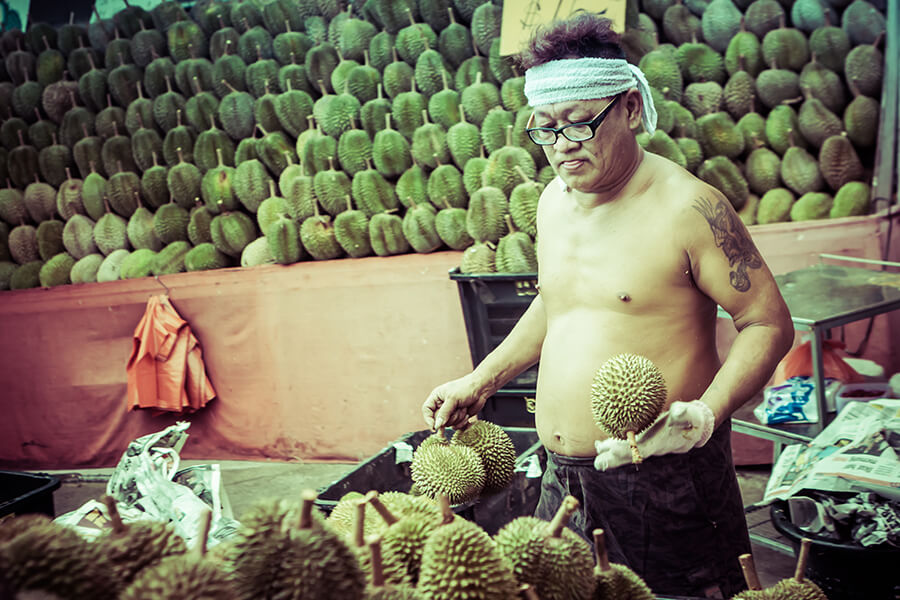
That being said, I’ve had mixed experiences with fruit vendors, because they are people too, with different motivations. It has run the gamut, from average, to crummy, to exceptional.
One time (“when I was still new to the game”), I bought a durian on trust, popped it in the under-seat storage of my scooter, drove a few minutes, and decided to open it up just to make sure, only to find out it was pretty rancid (meaning, ripe).
I took it back, and they gave me a new one (which was a surprise), but refused to take the old one back (which was an even bigger surprise). They knew it was bad, wanted to unload it on to me, succeeded, but then did the right thing when they realized I knew what had happened.
DON’T Rely on the “Tappy Stick”
One of the fruit vendors’ tools of choice is the tappy stick. That long stick of thin wood, with a thick piece of rubber at the end.
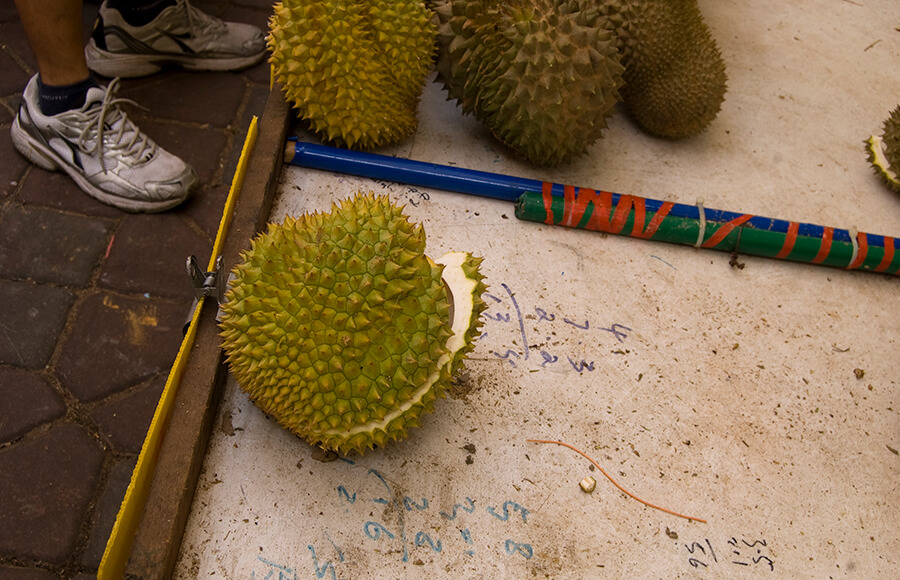
via Flickr/kodomut
They can smack durians with that thing all day long, but at best, the sound a durian makes will tell you that at least it isn’t a cinderblock, and gives far from a complete/accurate picture (especially since the sound is one of the hardest things to judge consistently due to other factors such as size, shape, and type).
“DON’T ‘Mon Thong’ Me”
If there’s one thing that will be shouted at you more than anything when picking durians (in Thailand in particular), it’s “Mon Thong!” (“Bantal Mas” in Malaysia – referring to the D159 cultivar/species of Durian). You may have wondered what they mean, and Mon Thong is a specific variety of Durian, and while one of the most popular, it is only one of over 300 varieties in Thailand alone.
Just know that the next time the fruit vendor shouts “Mon Thong!” at you, it is the type of durian that is being described, and says nothing about the ripeness of that particular fruit your holding.
DON’T Worry About the Size or Shape
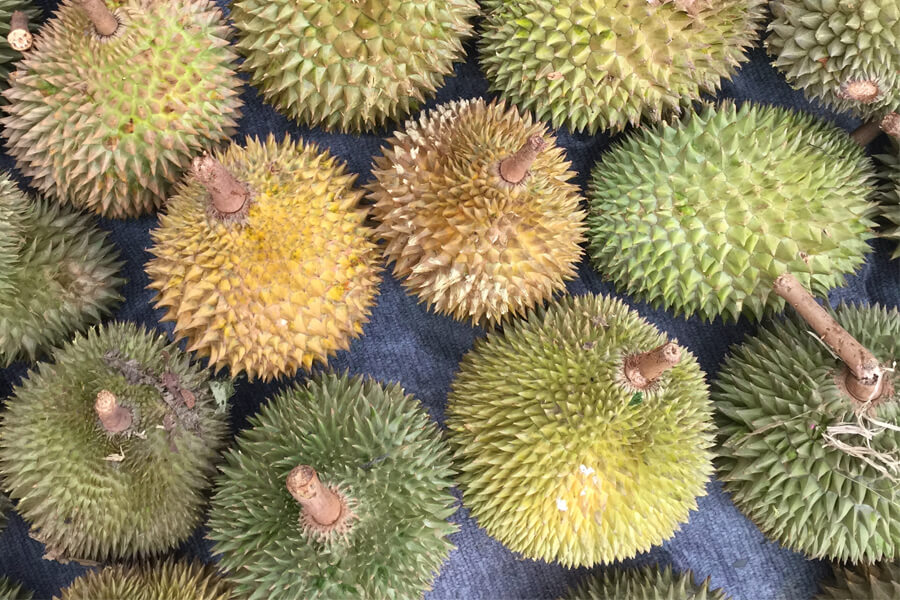
While there are particular characteristics of the way the durian “pods” appear that will give you more bang for your buck (generally, durians with bigger, more bulbous pods will give you more durian “flesh” compared to inedible husk when buying whole durians), the dimensions of your durian don’t necessarily impact the ripeness. However, they may determine the flavor, as the size in shape of a durian can help indicate which variety you are eating – usually, one of the 3 main varieties which vary from long and bulky to short and round.
DON’T Look at the Stem
Short stems, long stems, broken stems, strong stems – just like the size and shape, these vary with different varieties of durian, and I have found no consistent link between stem characteristics and the ripeness or deliciousness of a durian.
I’ve run into the gamut of different stem situations with durians. Some seemingly healthy stems fell off as soon as I grabbed them (causing scratched up calves and thrown out shorts – followed by a new habit of also grabbing them by their bottoms as well… more on that later), while the wispy, gnarled, fibrous remnants of others looked more like the hair on a Troll doll than a stem, but held up fine.
Whether the stem is barely holding on, has already fallen off, or appears in good or bad shape, is not an accurate indicator of how good a durian is.
A lot of things could have happened to that stem in transport, and different varieties of durian will have different stem characteristics, so unless you’re trained in the fine art of the discernment of durian species, you’re more apt to get confused by trying to figure out sweetness levels, or more importantly ripeness, by the status of a durian’s stem.
DON’T Be Fooled by the Spikes
There’s an old wives’ tale that pinching two durian spikes together can give you some valuable reconnaissance about the state of its interior.
Just like the past few points, the characteristics of a durian’s spikes’ flexibility gives little valuable insight into its contents.
We’ve reached a sad state of affairs indeed when all we’ve got left in our toolbox is a Hail Mary like pinching spikes.
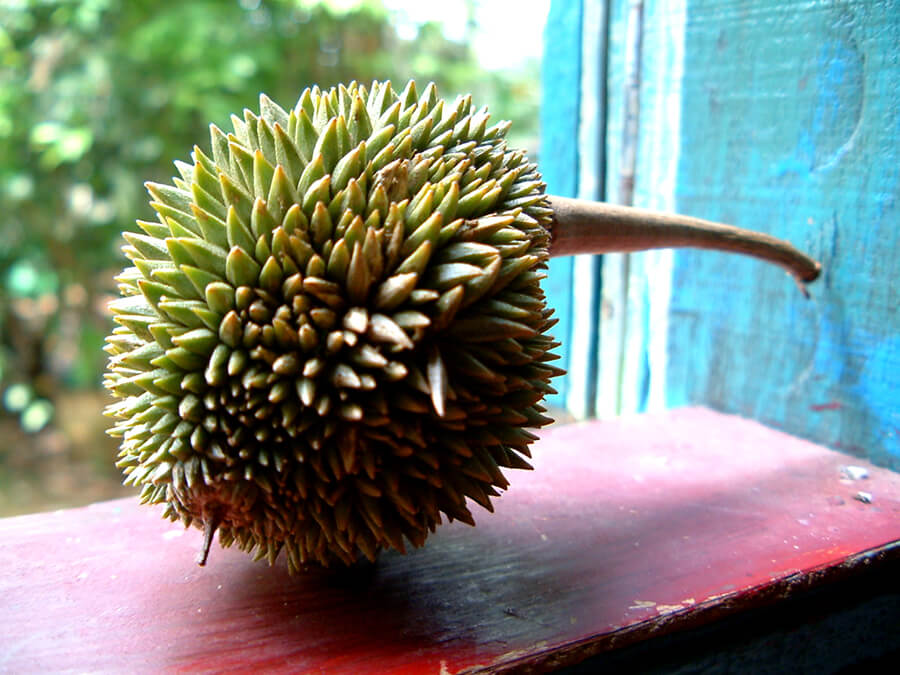
You try picking durians by pinching spikes together – tell me where that gets you.
How to Pick Durian: The One True Way
Now that we’ve dispelled some of the myths of picking a durian, I am going to share the one true method of picking a properly ripe, delicious specimen of durian.
It’s a method that I have honed over the years, and has led to not only a nearly perfect hit rate with picking the “best of the bunch” durians, but has also earned me the respect of fruit vendors throughout Southeast Asia.
Nowadays, I see a consistent pattern of fruit vendors starting their pitch (usually along the lines of “Good! Good!” Or “Mon Thong!”, etc.) then immediately stopping mid-sentence once they realize I know what I’m looking for.
This process works for both whole durians, and individual pre-wrapped pieces. However, the steps are slightly different, so they will each be covered in their own section.
Picking the Best Whole Durians
Step 1: Don’t Judge a Fruit by its Color
By now, you’ll know that there are plenty of varieties of durian, which exhibit variance in size, shape, stem length, characteristics of the spikes, color, and so forth – and the details matter.
However, the last of those, color, will still be our starting point when picking durians, although we will use it in a relative way.
Some durian varieties will be perfect when outwardly appearing green, others when brown, and still others yellow. Having a steadfast rule will get you into trouble, as many durians are rancid by the time they have a yellow tinge.
The way we start with color, is relative to the other durians in the batch. It’s the first form of categorization.
Generally speaking, if some of the durians have at least a bit of brown on their exterior (the more the better, usually, while still having some green), start with those.
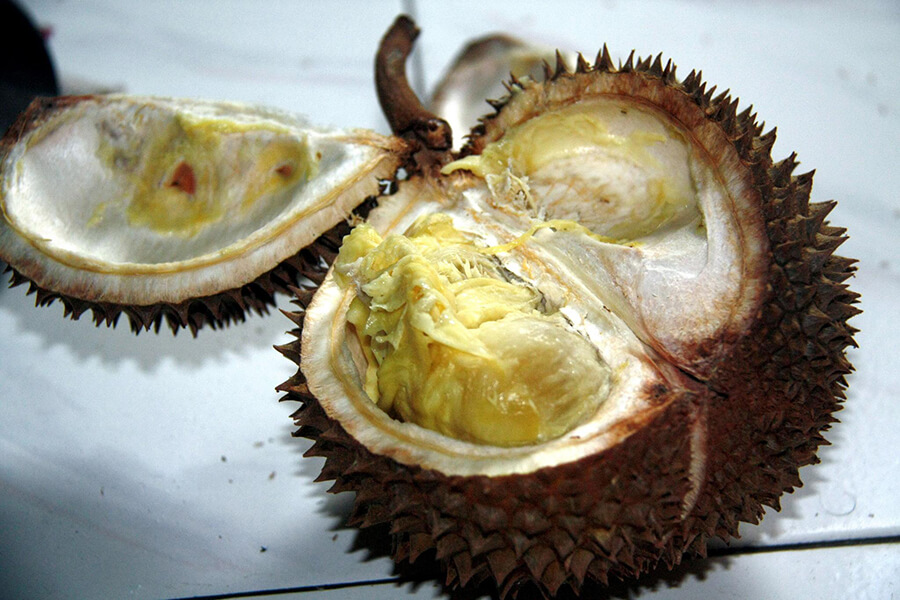
via Flickr/fitri agung
You can then go back and forth along the color spectrum (green – brown – yellow) based on what you find on the next steps, so you don’t spin your wheels trying multiple durians unnecessarily, until you get the idea of the best color range for the durians available where you are.
Step 2: Don’t Drop the Baby
The next thing you’ll want to do is lift the durian up.
This may seem obvious, but if you recall my reference to cut up calves and don’t want to throw away your clothes (nor mend your wounds) due to holes from falling durians, you’ll want to be sure to pay heed to the instructions on how to pick up a durian without needing gloves.
The concept behind picking up a durian without getting cut, is similar to sleeping on a bed of nails: find the highest concentration of spikes, and spread them across a large surface area.
What that means, is that you lift the durian by the stem (lift it slowly at first to make sure it isn’t going to come off), and hold the base of it with your palm – no fingers needed.
Unless you have a glove or a complimentary copy of last week’s newspaper handy, lifting durians this way is the best way to make sure you won’t get cut from a misleading durian stem, and letting the durian rest on your palm won’t cause you any scratches unless you jerk it around suddenly.
You’re welcome to try your luck with just the stem, but I’ve lost enough garments due to this method that I won’t personally chance it.
Step 3: Step Into Hell…
People cleverly quip about durian: “Tastes like heaven, smells like hell.”
Like What You See?
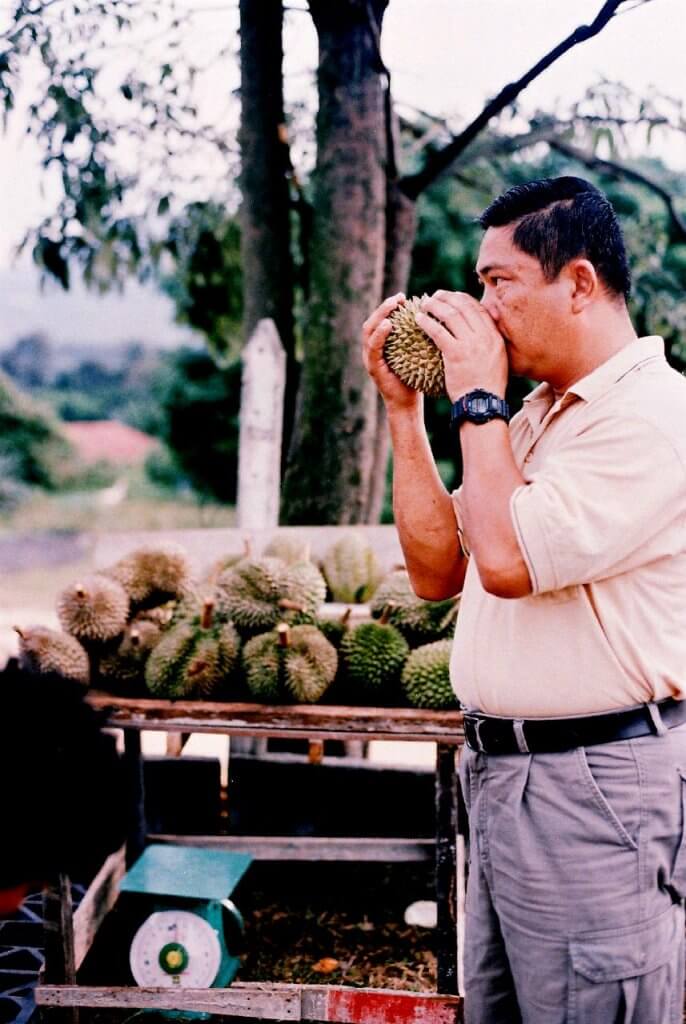
via Flickr/hokaicila
What they are referring to, is that raw sewage/gasoline/feet/rotting onion smell – the debate goes on, something like the blue/black/gold dress debacle – and I hate that smell too. Not only is it repugnant, it also indicates a durian that is well past its prime.
When it comes to durian, it is its smell that reveals everything you need to know about how ripe, and how delicious it will be.
As hard as that might be to hear, it’s the truth.
But, the good news, is that you don’t have to worry about the nasty durian smells. If you smell nastiness in any of its forms, stay away from that particular durian.
Step 4: …And get used to it…
So, how do you smell it in particular? What are you looking for? (smelling for?)
The first thing to do is to get a sense of what green fruit smell like. Much like wine, you have to develop an olfactory palette.
The easiest (and cheapest) way to do this, is to get at least two bunches of bananas (or singles), one that’s properly ripe and yellow, and one that’s still got some green on it, and might be ready in 2-3 days. You’ll probably want to buy them first, unless smelling bananas in public is normal in your country.
If you can get another two bunches – one that’s totally green, and one that’s starting to brown – even better, but not totally necessary. And, if those bananas can be the delicious Thai plump bananas, all the better – those are amazing (to eat after you’re done).
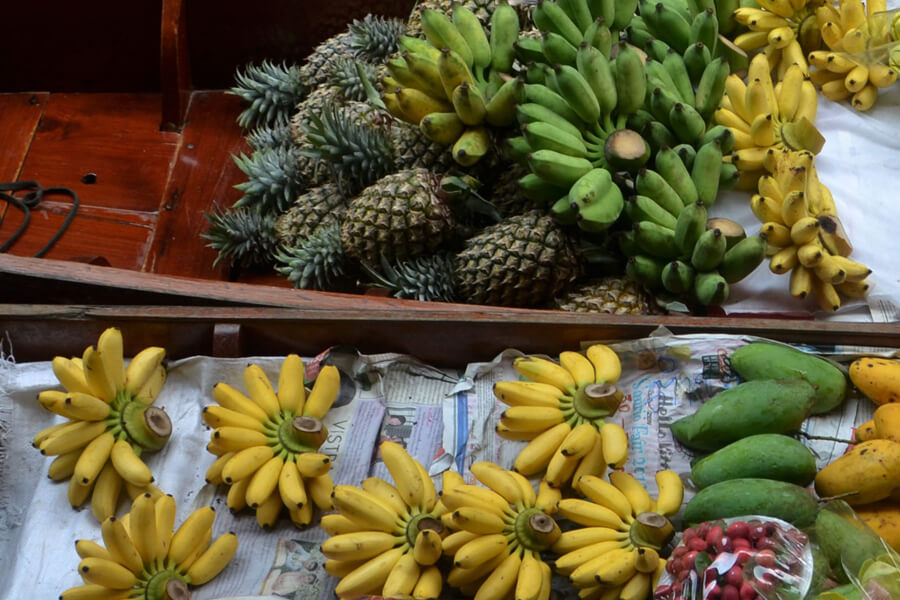
When you have your 2-4 (bunches of) bananas (and are safely at home where people won’t think you’re crazy for smelling bananas), give the different ripenesses a sniff, and get a sense of what green fruit smells like.
Once you can discern that aroma, you’re ready to endeavor into the rewarding world of picking properly “ripe” durians.
The reason that “ripe” is in quotes, is that it’s a misnomer. Remember that by the time a durian is technically “ripe”, it is almost rancid.
Step 5: …Then Test the Waters…
Instead, what you want to smell in a good durian, is a bit of greenness. Just a hint. But, there is indeed a spectrum, and as you get more experience, you will figure out how much of that “green smell” means it’s ready to eat today, how much means it’ll be ready tomorrow, or within the next few days (don’t chance it any more than that).
The main smell of the durian should still be sweet, pleasant to some, still off-putting (but nowhere near rancid) to others, but it should be there.
Indeed, when you encounter a group of durians (Incidentally, what do you call a group of durians? Gaggle? Horde? Murder? I perhaps would call them nestle. A nestle of durians.), you will in very short order be lured by their “group funk”. If you encounter durians that collectively have little-to-no smell (as is often the case in supermarkets), you may have to dig around to find whether there is one which exudes the infamous odor.
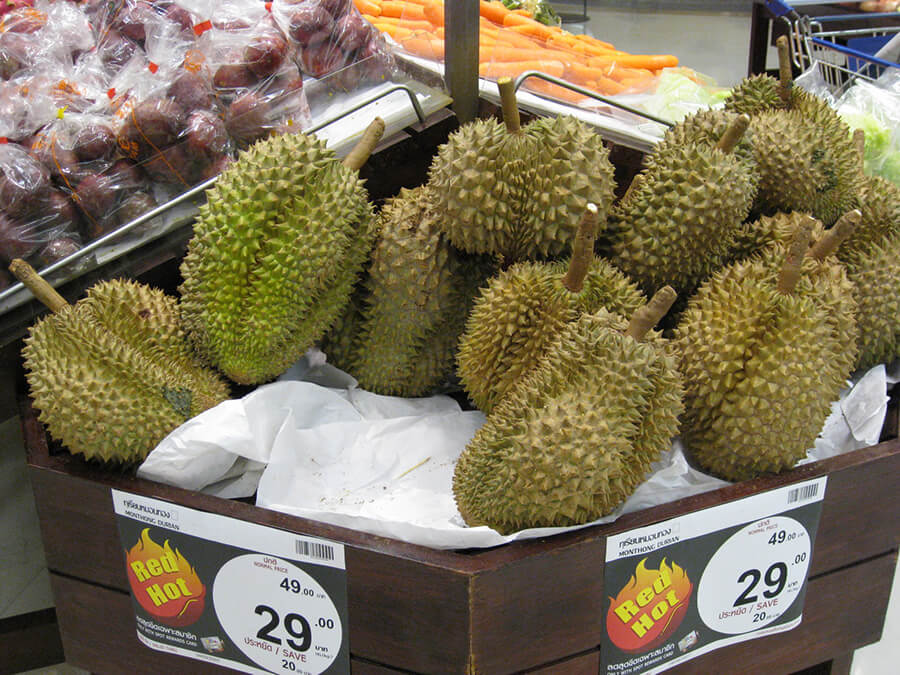
via Flickr/Glen MacLarty
If a durian doesn’t smell, or smells nearly totally green, you aren’t buying a durian, you are buying a cinderblock, which won’t ripen, no matter how much time you give it.
This too exists on a spectrum, but in a slightly different way. The spectrum in this case, is physically represented on the durian itself.
Meaning, if the durian meets your smell criteria, make sure you smell it all around, from top to bottom, and side to side – all 360 degrees.
The reason, is that durians don’t always ripen all the way through. If the smell isn’t consistent, neither is the ripeness. You may have a durian that smells perfect on the bottom (which is usually the first part to ripen), but from which you smell next to nothing at the top. Guess what, most likely, two-thirds to half of that durian will probably be a cinderblock that you’ll have to throw out (or fry and pretend it tastes good).
The same goes for individual pods.
If 70% or more of a durian smells strongly, then it is likely it will be fully ripe within the next day or so. If it’s 50% of less, then you are taking a gamble, and the more acute the smell (e.g. only one side), the bigger the risk that the rest of the fruit won’t catch up.
Step 6: …And Watch Out for Sharks
This metaphor has certainly gone on a wild ride.
Even if the durian smells perfect, there are still some things that can potentially detail a good durian.
The most common thing to look out for, is a bunch of holes in the outer husk of the durian, because they are indicative of bugs that have eaten/burrowed into the durian (sometimes this is present tense, and they’re alive & well). A small number of holes are okay, as this usually indicates the problem was caught early, and the durians are generally fine.
That being said, if the vendor is willing, ask them to cut the durian open a little so you can pike the flesh.
Yes, that means that if it’s already opened, somebody else has done that before you – and probably at least a few people. If you’re a germophobe, this is also something to look out for, as it’s not the most sanitary practice, but commonplace none the less.
However, remember that durian flesh gets ripe from the bottom up generally speaking, so if you do ask them to open it, get it cut about 4/5 of the way up, and then very close to the bottom.
For these 2 locations, they’ll either make triangular cutout of the husk at the top, and crack the bottom slightly along the durian fault lines, or if they’re very confident in their product, they will use that crack to open it all the way up. That in and of itself is a sign.
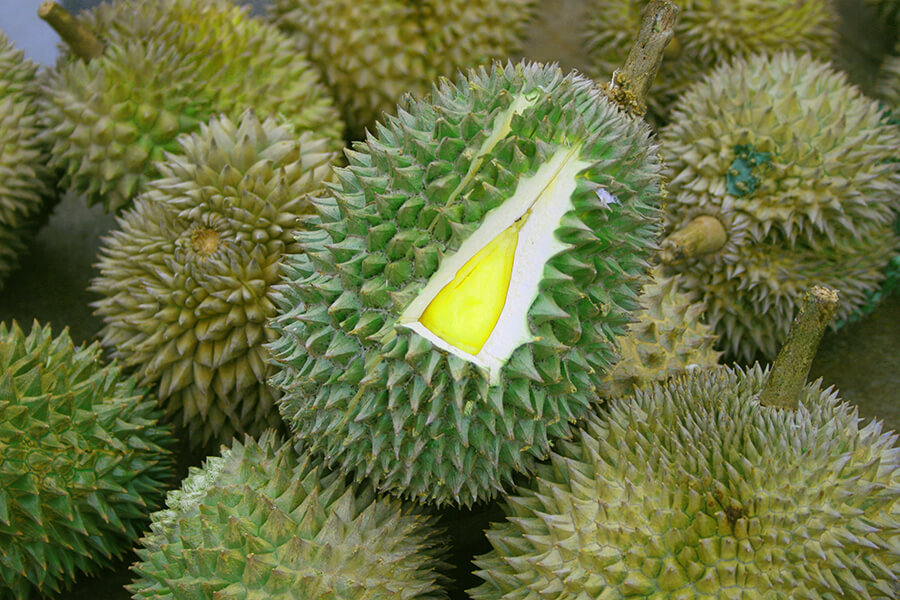
If they don’t offer to open it all the way, but seem like they would be particularly accommodating, just ask them to open up an entire pod (if it has a lot of holes, or you suspect it is over/under ripe, ask them to do it on that particular pod), and ideally so you can see the inside part (where the durian flesh “connects” to its “spine”).
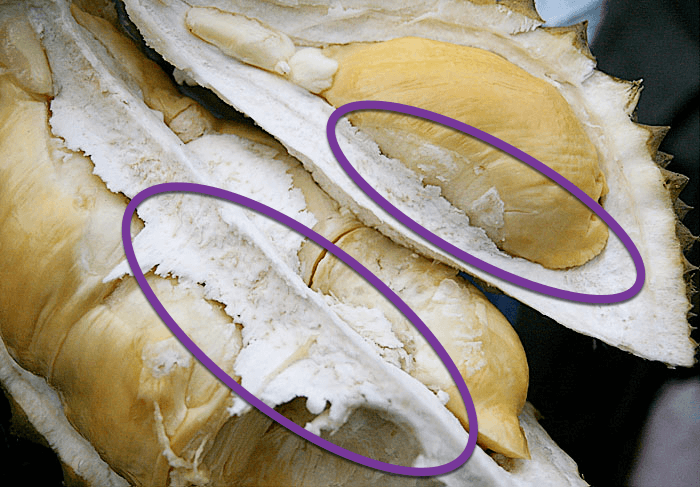
There are a couple of reasons for these criteria:
Firstly, the inner section is usually where any bugs hide (and if you can see all the way around the “meat”, you’ll be sure to see the majority of any that exist). Finding a couple of bugs, especially on street-vendor/fruit market durian, is to be expected, and for any seasoned durian vet, not a big deal. If you’re squeamish, or if there are a lot of bugs, this can disqualify the durian for you then and there. At the very least, the bottom of the durian offers greater insight into any potential bug situation (since you can usually see all the way around the base of the flesh) than the triangle cut at the top.
Secondly, you’ll recall that durians don’t always ripen evenly, so the more “data points” you collect, the more likely you are to pick a durian that is consistently good. I’ve had durians opened where the bottom was mushy – well overripe – which I bought because it was the start/end of the season and I was just happy to find something, then when I brought it home, found the top was rock hard. Bleh!
Until you’re super confident in your durian picking abilities, try to get them to open the durians all the way up, or at least get the triangular window up top, and a sneak peek & poke down bottom.
After you have your preview, use the steps from the next section (how to test shrink-wrapped durian) to also test the durians they open up for you, so you can use the experience to hone your expertise, until you no longer need to open the durian before you buy it.
Picking the Best Pre-Packaged/Shrink-Wrapped Durian Pieces
Whether you’re opening up a whole durian and wanting to test the flesh, or buying pre-packaged pieces of durian, here’s what to look (and smell) for in getting good durian.
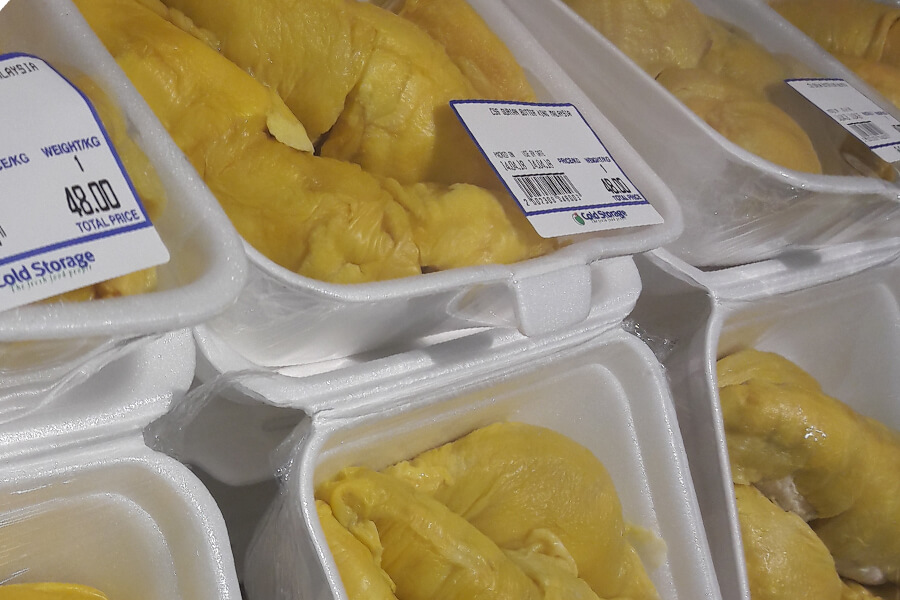
via Flickr/Bingxion Chen
Step 1: Unlike People, Not All Durian Colors Are Created Equal
The first thing you’re going to want to do is locate a suitable candidate based on the color of the flesh.
Picking shrink-wrapped durian – like whole durian – is an interactive process, and the fruit vendors aren’t going to like you invading the space of every single saran-wrapped styrofoam tray they have on display (or in the case of whole durians, poking through every triangular peep hole they’ve installed).
Durian colors can vary from white/cream colored, to different shades of yellow, orange, and even red.
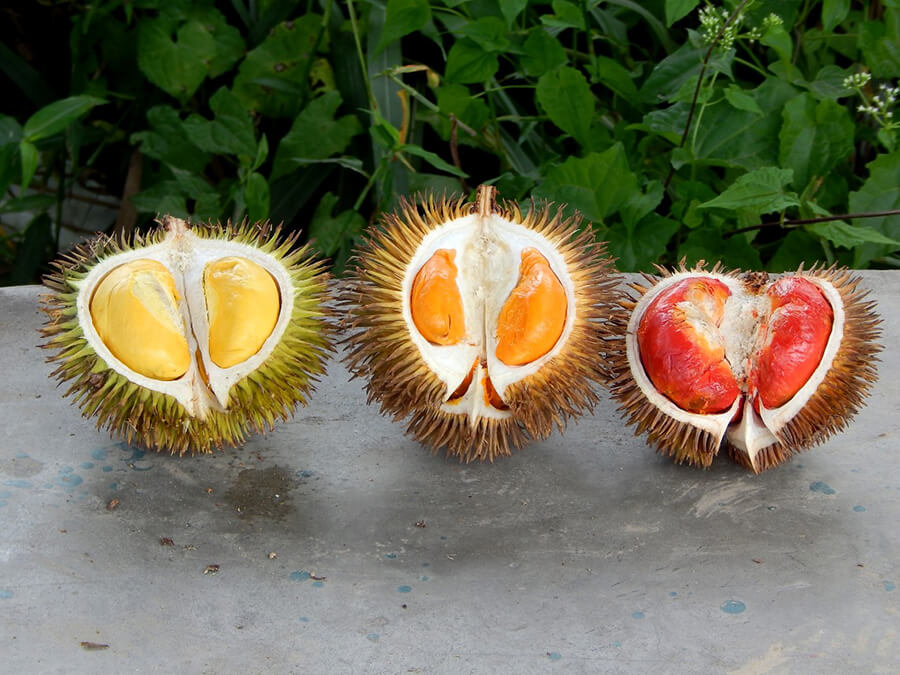
via Petr Cech
While the variety you encounter will depend on where you are and what time of year it is, (and there is plenty of variance to be had!), probably the variety of durian you will encounter most often from street vendors and supermarkets (especially in its saran-wrapped form), will have some shade of yellow flesh.
Based on that assumption, you’re going to want to look out for it looking too white (which will usually be accompanied by it feeling very hard), too deep yellow (which will usually have flesh that’s already a bit warped or soggy), or even starting to brown (which is the next step after yellow in “ripeness”).
If you are dealing with durians of different colors, simply find out what the actual color is supposed to look like, and apply the same principle of a spectrum: not too light, not too dark.
Step 2: Touchy, touchy!
When you find one that you think looks right, poke it, GENTLY, so as to not disturb the fruit vendor (or the skin of the durian flesh) – all the testing in the world isn’t going to get you a durian from somebody who you’ve pissed off to the point of shooing you away.
It should be firm, but offer a little movement. A perfect litmus test for this is your “thumb meat” – the muscle of your thumb – when you make an OK ? gesture with your hand (touching the tip of your thumb to the tip of your index finger).
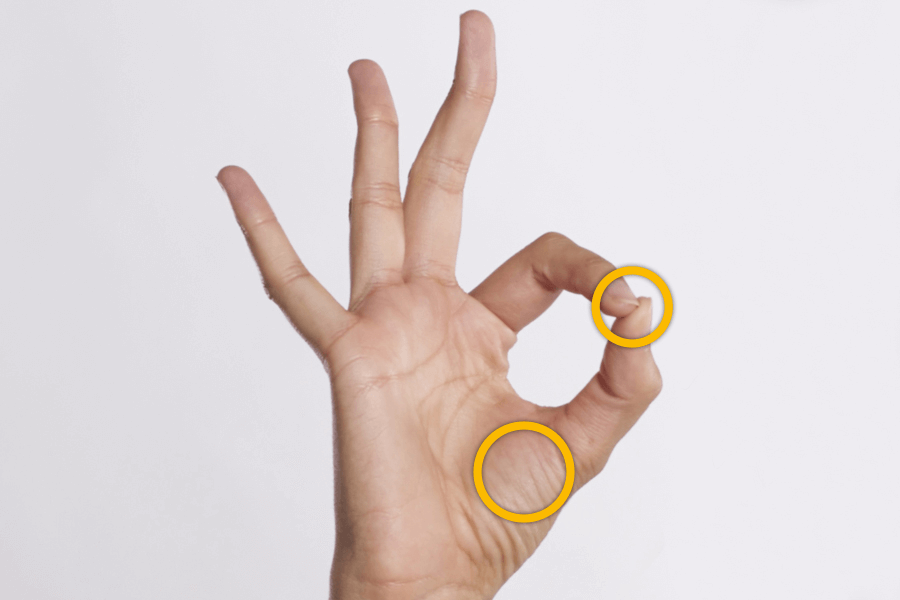
The durian itself should have the same firmness with pushback as the thumb muscle itself when you make the ? gesture, and the skin should either be tight (depending on the variety), or at most, move just a little bit, like the skin on your “thumb meat” is in that same gesture.
That exact “has a slight give but with definite push-back” feeling is what you’ll want from your durian. The flesh shouldn’t permanently warp when you push it (provided you do so lightly), instead, it should go back to its original place.
While this too will differ based on the type of durian, generally, the further you get from the “rule of thumb”, the more likely it is to be overripe (soft, squishy) or under ripe (hard, immovable).
Step 3: See Step 4
After finding an ideal candidate from looks and touch, you go to ole reliable: smell (Step 4 from how to pick a whole durian).
The difference, is that the flesh itself should have a slightly sweeter smell to it than the whole durian, with only the slightest tinge of “greenness” to it – if any. The ones that have just barely a green smell are going to be the closest to perfection, but the degree of subtlety you’re looking for in the smell is often over-powered by being so close to the source of the durian stank, that it can be easy to over-shoot the mark at first.
Like What You See?
The closer you walk the line on this one, the better, but, you are less at risk of overripe durian compared to whole durian, if there is no hint of greenness whatsoever in the flesh.
If you don’t feel comfortable with your visual/tactile identification skills yet, you can replace Steps 2 and 3: smell them first, then a little touchy touchy to seal the deal. At least that way, the vendor won’t be so quick to upset with you defacing the merchandise!
Conclusion
After years of avid durian connoisseurship, plenty of failed tests, and plenty of wrong turns with inaccurate testing measures, I’ve honed the skill of picking a proper durian.
No more relying on “tappy sticks” or eating nasty durians; honing and using your sense of smell in these ways will give you dominion over the king of fruits, including avoiding the nastier of the durian smells.
Remember, there are two kinds of people:
If you’re the kind that loves durian, you now have an indispensable tool that will help you get more of the good stuff.
While it takes some calibration and practice (which, by using the banana trick, you can do without wasting *too many* durians), when you get a hang of picking durian based on smell, you’ll be able to pick a perfect durian as if you were a sommelier – not too hard, not too soft, not too watery, and if you’re one of those people who don’t use durian as air freshener, hopefully not too smelly either (or you could always hang it outside).
On the other hand, if you’re the kind of person who hasn’t had properly ripe durian, give these techniques a shot. Durian is a true delicacy, and you may find that trying a really good durian (picked the right way) opens up a whole new dimension of gastronomic delight.
There are many of us who eagerly await the durian season (which is actually year-round, somewhere), and still others for whom durian is an integral part of why they travel. I know I get very excited when durian is near (you can always tell, can’t you), and I also know that a lot of the people I’ve heard say “ew, durian!” just haven’t ever had a good one.
Hopefully, more of those of us who love durian will find better durians to enjoy, and more of those who don’t yet know the true joy of durian, will find their first good one. Then, it’ll just be a matter of opening them.
How about you?
What’s your hit rate with good durian?
Are you willing to deep-dive into the smell to find a great one, or do you have a totally consistent way of your own?
